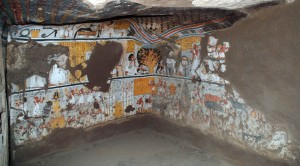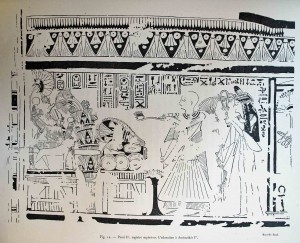There are two separate looting issues in TT16. The most noticeable feature of the tomb’s state of preservation is the damage done by robbers who have hacked out 6 scenes in the tomb. This damage was done before the 1980s. In her book City of the Dead. Thebes in Egypt, (1987) Lise Manniche makes reference to the clearing of the tomb: “The passage behind the transverse hall has been cleared in recent years and a shaft leads deep into the rock to a burial chamber below. The path is littered with bones and fragments of paintings provisionally stored in baskets.” A photo of the scene next to the tree goddess in room 1 (on p. 75) shows that damage had been done before the date of publication. A color photo published in a different book in 1965 (Egyptian painting and the Ancient East by Robert Boulanger) shows the same image of the seated couple behind the tree goddess in the first room intact. Since the exact date these photos were taken is unknown, and the exact date of the conservation is unknown, we can only narrow down the time frame to about 20 years, between the mid-1960s and the mid -1980s. This gives us our 20 year estimate for the time frame in which the robbing occurred.
The exact date of the clearing and conservation is unknown, but an initial inquiry at the west bank taftish indicated the work was done by the Egyptian government in the 1950s or early 1960s. Several areas of old plaster fall were filled in with a modern mud and straw mixture, typical of conservation from the mid-20th century. These areas of older damage are recorded in Baud and Droiton’s epigraphic volume on the first room (MIFAO 57.2; 1932), and are visible in the 1960s Chicago House photos. The theft of the scenes occurred after the government restoration as the cut marks of the looters sometimes extend into the conserved areas. Also, if the damage had been there when government work occurred those areas surely would have been restored with the rest of the tomb.
Chicago House photos taken in 1956/1957 show some of the tomb intact before the SCA conservation and clearing. Center of Documentation photos date to 1999 and show the damage already done (as expected since Manniche’s 1987 publication shows it already damaged). In 2007, one of the former inhabitants of the home on the hill above the tomb stopped by one day and told me that the tomb had been standing open without any door as recently as 15 years ago. This fits with what others have told me about the installation of doors on the tombs in the 1980s. Theft of the scenes could have easily happened any time before that as the tomb sits very close to the main road and would have been easily accessible. It is also situated between two alabaster factories at the base of a hill, so anyone entering the tomb could do so without being too visible.
These two images demonstrate the level of damage present in the tomb. The looter damage in the center of the color photo is adjacent to an area of earlier restoration style. The looters probably intentionally avoided taking the image of Amunhotep I on his carrying chair since it was reasonably well known. With careful preparation, the looters could have easily carved off the names and titles of the individuals in the scene, rendering them annonymous Ramesside people. Throughout the tomb, the looters focused on taking the heads and upper torsos of the figures, and in some places deliberately avoided text or any unusual scenes that could identify which tomb they came from.



